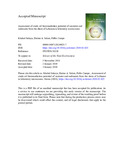JavaScript is disabled for your browser. Some features of this site may not work without it.
| dc.contributor.author | Sakaya, Khaled | |
| dc.contributor.author | Salam, Darine A. | |
| dc.contributor.author | Campo, Pablo | |
| dc.date.accessioned | 2019-01-10T19:55:36Z | |
| dc.date.available | 2019-01-10T19:55:36Z | |
| dc.date.issued | 2019-01-04 | |
| dc.identifier.citation | Sakaya K, Salam DA, Campo P. (2019) Assessment of crude oil bioremediation potential of seawater and sediments from the shore of Lebanon in laboratory microcosms. Science of the Total Environment, Volume 660, April 2019, pp. 227-235 | en_UK |
| dc.identifier.issn | 0048-9697 | |
| dc.identifier.uri | https://doi.org/10.1016/j.scitotenv.2019.01.025 | |
| dc.identifier.uri | http://dspace.lib.cranfield.ac.uk/handle/1826/13814 | |
| dc.description.abstract | With the planned oil and gas exploration activities off the coast of Lebanon, the risk of shoreline contamination with crude oil spills has become a major concern. This study aimed at assessing the crude oil bioremediation potential of the chronically polluted Lebanese shores in light of the continuous discharge of nutrient-rich sewage into the Mediterranean Sea and the long-lasting absence of proper sewage treatment systems. It was anticipated that, with the high pollution levels of the coastline, background concentrations of nutrients would be sufficient to sustain high intrinsic biodegradation rates without human intervention. Biodegradation experiments were conducted using crude oil-spiked beach sediments and seawater under natural attenuation and biostimulation conditions. The experiments were conducted at 18 and 28 °C to account for seasonal variation in temperature, background nutrient levels, and microbial communities. The biodegradability of oil constituents – namely alkanes and polycyclic aromatic hydrocarbons (PAHs), was monitored over a 42-day period using gas chromatography–mass spectrometry (GC–MS). Under biostimulation conditions, significant enhancement in the overall biodegradation rates of alkanes and PAHs was observed in seawater at 18 and 28 °C, while little to no improvement was measured at both temperatures in sediments where background nutrient levels were sufficient to induce near maximum intrinsic biodegradation rates. Under both natural attenuation and biostimulation treatments, the increase in temperature increased the oil biodegradation rates in sediment and seawater microcosms. In both instances, the overall trend in the biodegradation of individual alkanes and PAHs suggested a typical decrease in biodegradation rates with the increase in carbon number/rings and alkyl groups. | en_UK |
| dc.language.iso | en | en_UK |
| dc.publisher | Elsevier | en_UK |
| dc.rights | Attribution-NonCommercial-NoDerivatives 4.0 International | * |
| dc.rights.uri | http://creativecommons.org/licenses/by-nc-nd/4.0/ | * |
| dc.subject | Crude oil spills | en_UK |
| dc.subject | Bioremediation | en_UK |
| dc.subject | Background nutrient levels | en_UK |
| dc.subject | Marine sediments | en_UK |
| dc.subject | Seawater | en_UK |
| dc.title | Assessment of crude oil bioremediation potential of seawater and sediments from the shore of Lebanon in laboratory microcosms | en_UK |
| dc.type | Article | en_UK |
Files in this item
The following license files are associated with this item:
This item appears in the following Collection(s)
-
Staff publications (SWEE) [2822]

